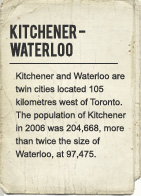Cemeteries
Around 1913, Mandel Steinberg moved to Kitchener from Toronto. He organized the purchase of a cemetery for the congregation, west of downtown at the corner of Victoria Street South and Westmount Road. Before this, the community had to travel to Hamilton or Toronto cemeteries for burials. When it was created, the Beth Jacob Cemetery was located outside of the town. In the 1930s, as Jacob Taraday told the Kitchener-Waterloo Record in 1971, they had to carry the coffins down the dirt track that was Victoria Street.
The cemetery’s earliest graves belong to children. Sam Davis died in 1913 at the age of 5 and Joseph Rosen was 10 years old when he died of diphtheria in 1916. As the years passed, the Beth Jacob Cemetery became the resting place of many of the community’s founders and their descendants. It was devotedly taken care of for many years by Donald Bierstock, who also compiled the life histories of many of the people buried there.
There is evidence as early as 1941 of a Chevra Kadisha in Kitchener. Beth Jacob’s 1941 constitution stated that the society was supervised by a committee of three members. The work of the Chevra Kadisha was performed by all synagogue members in turn when their name was drawn. In the 1950s, the society even hosted an annual party. In the 1990s, the work was revived by a committee of volunteers, and today a community Chevra Kadisha performs this important mitzvah for both congregations.
After Kitchener-Waterloo’s Reform congregation, Temple Shalom, formed in the late 1960s, its members needed a burial place of their own, since non-Jewish spouses and children of interfaith marriages could not be buried in Beth Jacob’s Orthodox cemetery. In 1978, Temple Shalom acquired a section in the City of Waterloo’s Parkview Cemetery. The section is reserved for any Reform Jew, whether a member of the Temple or not, and is open to non-Jewish spouses and children.







